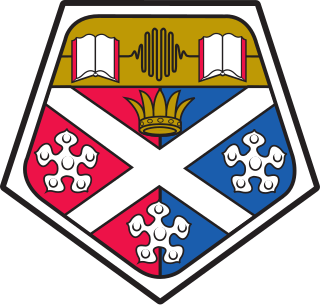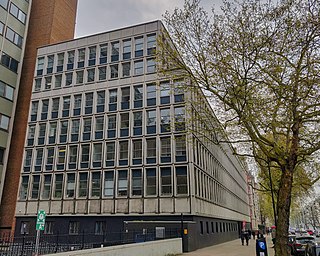
The University of Strathclyde is a public research university located in Glasgow, Scotland. Founded in 1796 as the Andersonian Institute, it is Glasgow's second-oldest university, having received its royal charter in 1964 as the first technological university in the United Kingdom. Taking its name from the historic Kingdom of Strathclyde, its combined enrollment of 25,000 undergraduate and graduate students ranks it Scotland's third-largest university, drawn with its staff from over 100 countries.
Degree abbreviations are used as an alternative way to specify an academic degree instead of spelling out the title in full, such as in reference books such as Who's Who and on business cards. Many degree titles have more than one possible abbreviation, with the abbreviation used varying between different universities. In the UK it is normal not to punctuate abbreviations for degrees with full stops, although this is done at some universities.
A Master of Engineering is a professional master's degree in the field of engineering.

The University of Moratuwa is a public university in Sri Lanka. It is located on the bank of the Bolgoda Lake in Katubedda, Moratuwa, a suburb of Sri Lanka's capital Colombo.

Camborne School of Mines, commonly abbreviated to CSM, was founded in 1888. Its research and teaching is related to the understanding and management of the Earth's natural processes, resources and the environment. It has undergraduate, postgraduate and research degree programmes within the Earth resources, civil engineering and environmental sectors. CSM is located at the Penryn Campus, near Falmouth, Cornwall, UK. The school merged with the University of Exeter in 1993.

Engineering education is the activity of teaching knowledge and principles to the professional practice of engineering. It includes an initial education, and any advanced education and specializations that follow. Engineering education is typically accompanied by additional postgraduate examinations and supervised training as the requirements for a professional engineering license. The length of education, and training to qualify as a basic professional engineer, is typically five years, with 15–20 years for an engineer who takes responsibility for major projects.
Strathclyde Law School was established in 1964 and operates within the Faculty of Humanities & Social Sciences at the University of Strathclyde, in Glasgow, Scotland.

The Regent University College of Science and Technology is located in Accra, Ghana. It was registered in September 2003, and received accreditation to operate as a tertiary institution in 2004. In January 2005 it started its lectures with 30 pioneer students at Trinity Campus, Mataheko.
The Department of Engineering at Durham University is the department engaged in the teaching and research of engineering across a broad range of disciplines. It is the successor department to the UK's first school of engineering, established at Durham in 1837.
The Guilin University of Technology has situated in the city of Guilin in Guangxi, China. It currently has more than 19,000 students. At present, it offers 59 undergraduate programmes and 35 postgraduate programmes including Management, Economics, Art, Literature, Engineering, Science, and Agriculture, as well as Chinese language courses designed for international students.

The University of Strathclyde’s Faculty of Education was housed at the renowned Jordanhill campus in the west end of Glasgow until 2012. Since relocating to the city centre campus the faculty has become the University’s, and Scotland’s first, Institute of Education.
The College of Engineering is one of the six colleges of the Kwame Nkrumah University of Science and Technology, in Kumasi, Ghana. It was established in October 1952 to prepare students for professional qualifications only. It has since grown and expanded and now as a college runs 15 BSc, 20 MSc, MPhil and PhD programmes under 3 faculties; the faculty of Electrical and Computer Engineering, the faculty of Civil and Geo Engineering and the faculty of Mechanical and Chemical Engineering and 10 academic departments.

Nile University of Nigeria (NILE) is a private multidisciplinary university established in 2009 and located in Abuja, Nigeria. It is a member of the Honoris United Universities Network and accredited by the National Universities Commission. Currently, it has eight faculties and a School of Postgraduate Studies offering 34 undergraduate programs and 47 postgraduate programs.

The Faculty of Engineering is one of the four faculties which make up the University of Strathclyde in Glasgow, Scotland. The faculty contains multiple departments offering different undergraduate and postgraduate courses. These range from BEng, MEng and MSc courses to doctorates throughout the faculty.

The Department of Chemical Engineering, Imperial College London is the centre of teaching and research in chemical and process engineering at Imperial College London, occupying the Aeronautics and Chemical Engineering Extension (ACEX), Bone and Roderic Hill buildings, on the South Kensington campus. Formally inaugurated in 1912, the department has over 40 faculty members, 100 postdoctoral researchers, 200 PhD researchers, 80 taught postgraduates, and 500 undergraduates. The department ranks 7th on QS's 2018 world rankings.

The Department of Computing (DoC) is the computer science department at Imperial College London. The department has around 50 academic staff and 1000 students, with around 600 studying undergraduate courses, 200 PhD students, and 200 MSc students. The department is predominantly based in the Huxley Building, 180 Queen's Gate, which it shares with the Maths department, however also has space in the William Penney Laboratory and in the Aeronautics and Chemical Engineering Extension. The department ranks 7th in the Times Higher Education 2020 subject world rankings.

The College of Engineering is a faculty at the University of Saskatchewan in Saskatoon, Saskatchewan, Canada.

The Department of Materials is responsible for the teaching and research in materials science and engineering at Imperial College London, occupying the Royal School of Mines and Bessemer buildings on the South Kensington campus. It can trace its origins back to the metallurgy department of the Government School of Mines and Science applied to the Arts, founded in 1851.

The School of Engineering, Trinity College Dublin is the oldest engineering school in Ireland and one of the oldest in the world. It provides undergraduate, taught postgraduate and research degrees in engineering. It is the highest-ranked engineering school in Ireland by QS Rankings and by Times World University Rankings.















